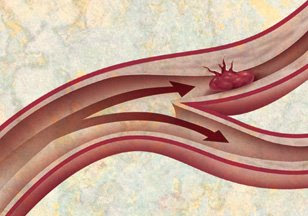What Are the Types of Stroke?:
If we consider an isolated blood vessel, blood flow to the brain tissue can be hampered in two ways:
- the vessel clogs within (ischemic stroke)
- the vessel ruptures, causing blood to leak into the brain (hemorrhagic stroke)
Ischemic strokes occur as a result of an obstruction within a blood vessel supplying blood to the brain. The underlying condition for this type of obstruction is the development of fatty deposits lining the vessel walls. This condition is called atherosclerosis. These fatty deposits can cause two types of obstruction:
Cerebral thrombosis refers to a thrombus (blood clot) that develops at the clogged part of the vessel.
Cerebral embolism refers generally to a blood clot that forms at another location in the circulatory system, usually the heart and large arteries of the upper chest and neck. A portion of the blood clot breaks loose, enters the bloodstream and travels through the brain's blood vessels until it reaches vessels too small to let it pass. A second important cause of embolism is an irregular heartbeat, known as atrial fibrillation. It creates conditions where clots can form in the heart, dislodge and travel to the brain.
Hemorrhagic stroke accounts for about 17 percent of stroke cases.
It results from a weakened vessel that ruptures and bleeds into the surrounding brain. The blood accumulates and compresses the surrounding brain tissue. The two types of hemorrhagic strokes are intracerebral hemorrhage or subarachnoid hemorrhage.
Hemorrhagic stroke occurs when a weakened blood vessel ruptures. Two types of weakened blood vessels usually cause hemorrhagic stroke: aneurysms and arteriovenous malformations (AVMs).
An aneurysm is a ballooning of a weakened region of a blood vessel. If left untreated, the aneurysm continues to weaken until it ruptures and bleeds into the brain. Download more information on aneurysm.
An arteriovenous malformation (AVM) is a cluster of abnormally formed blood vessels. Any one of these vessels can rupture, also causing bleeding into the brain. Download more information on AVM.
Also called TIAs, transient ischemic attacks are minor or warning strokes. In a TIA, conditions indicative of an ischemic stroke are present and the typical stroke warning signs develop. However, the obstruction (blood clot) occurs for a short time and tends to resolve itself through normal mechanisms.
Even though the symptoms disappear after a short time, TIAs are strong indicators of a possible major stroke. Steps should be taken immediately to prevent a stroke.









No comments:
Post a Comment